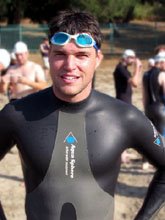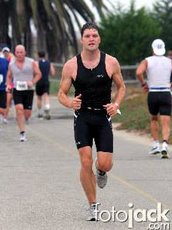 Wha—? How to touch my toes? Please! What kind of topic is THAT? I've been touching my toes since first grade gym class already! Let's hear about carbo-loading, descending sprint-intervals, heart-rate monitoring! Look, I know how to touch my toes... I'll even show you, just bend down and -- (sound of spine snapping) -- AK! OW! GOFF!
Wha—? How to touch my toes? Please! What kind of topic is THAT? I've been touching my toes since first grade gym class already! Let's hear about carbo-loading, descending sprint-intervals, heart-rate monitoring! Look, I know how to touch my toes... I'll even show you, just bend down and -- (sound of spine snapping) -- AK! OW! GOFF!Well, maybe your spine won't snap, exactly. But, believe it or not, most of us need a little primer on how to touch our toes. Because almost everybody does this simple move ineffectively. What we're trying to do, ostensibly, is stretch out an area that is generally tight (the hamstrings) -- but instead wind up stretching another area in a direction that it's already overstretched anyway (the lower back).
Confusing? A few words on flexibility.
 Several months back, the famous Tall Ships came through the LA area and I took my daughter, Kate, to go see them. As usual with such outings, Kate only glanced at the ships and fixated on a far more interesting plastic bottle top for the entire afternoon. Kate's indifference notwithstanding, the ships are remarkable vessels, their sails held firmly together in place by what looks like miles of rigging.
Several months back, the famous Tall Ships came through the LA area and I took my daughter, Kate, to go see them. As usual with such outings, Kate only glanced at the ships and fixated on a far more interesting plastic bottle top for the entire afternoon. Kate's indifference notwithstanding, the ships are remarkable vessels, their sails held firmly together in place by what looks like miles of rigging.Now I'm not the nautical type, but in some ways you can think of your muscular system like one of those old-fashioned sailing ships: each muscle, like each sail on a ship, is held in place by connective tissue that, ideally, is equally taut in all directions. If one side of the rigging is too tight while the other is too loose, you get a sail that's pulled off kilter and doesn't function quite right. Or if both sides are pulled too tight, there's a chance a strong wind or a clumsy deckhand might just rip that sucker right in half.
Same with your muscular system: if you're inflexible, your muscles, joints and bones get pulled off track, making you more susceptible to muscle pulls and injuries. Keep the connective tissue optimally flexible and you'll be able to move freely and easily without pain or strain.
Hey, this analogy's working out better than I thought!
 Here's where it gets tricky: note I don't say "maximally" flexible. Flexibility for its own sake is dicey and potentially dangerous. Muscles, tendons and ligaments have a fair amount of stretchiness built in, but once you overstretch them, it's hard to get them to snap back -- they can remain permanently lengthened: belaboring the analogy just a bit, your muscles can become like sails flapping ineffectively in the wind. Highly skilled yogis spend decades building up their flexibility so they can perform their feats of contortionism without injury -- but you and I need to proceed with caution. And we need to attempt to keep our bodies equally flexible in all directions: front, back, side, side. We want all our sails well-rigged.
Here's where it gets tricky: note I don't say "maximally" flexible. Flexibility for its own sake is dicey and potentially dangerous. Muscles, tendons and ligaments have a fair amount of stretchiness built in, but once you overstretch them, it's hard to get them to snap back -- they can remain permanently lengthened: belaboring the analogy just a bit, your muscles can become like sails flapping ineffectively in the wind. Highly skilled yogis spend decades building up their flexibility so they can perform their feats of contortionism without injury -- but you and I need to proceed with caution. And we need to attempt to keep our bodies equally flexible in all directions: front, back, side, side. We want all our sails well-rigged.Like that team of well-meaning but slightly bumbling college-intern deckhands hired by a ship captain for the summer, your body adjusts your rigging to accommodate whatever stimulus you throw at it (SAID again!). So, what do most of us, even the most ACTIVE among us, spend most of our time doing? Sitting. And usually, we're sitting with our arms forward, typing or driving.
Picture it -- or more likely, just feel it, where you are right now. Sitting TIGHTENS the hip flexors (where your thighs connect to your torso), the hamstrings (backs of your legs), the chest, shoulder muscles and abdominal muscles; conversely, sitting also LOOSENS the spinal erectors (supporting the lower back), scapular retractors (between your shoulder blades), and gluteals (butt muscles). A physiologist would add a few other hard-to-pronounce muscles, but that's the gist of it.
So by and large, with the exception of the hamstrings, the muscles on the front of your body are tight while those in the back are loose. That's why it always feels so great to open your chest, arch the back, and stretch the arms back and behind you after you've been sitting for awhile. Go ahead and do it now; I'll be here when you get back.
Feel better? Okay. One of my goals when I work with clients is to correct some of the bad habitual rigging that nearly all of us acquire after decades on our tucki. I'm as guilty as anyone: even if I work out ten hours a week -- which I almost never do -- it can only go so far to negate the effects of the other 40-50 hours I spend driving, sitting at my desk and watching TV.
Five to ten minutes of flexibility exercises, however, can work wonders -- at the very least to get you to feel your body properly aligned before you go back to the (sedentary) corporate grind.
So, on to toe-touching. When you reach forward to touch your toes in the usual way -- by rounding your back -- you're stretching two major areas: the hamstrings and the lower back. And for most of us, it's MOSTLY the lower back because we have more mobility there than in the hamstrings. Remember, when we sit (I'm talking slumping here, which, yes, I'm doing at this moment myself), our low-backs are already in forward flexion while our hamstrings are contracted. So stretching the lower back forward even more does most of us very little good. And the poor neglected hamstrings are largely ignored in the process. That's why most of us feel very little in the hamstrings when we do the traditional toe-touch and more often feel a scary pull in the low-back.
What's the remedy? After all that preamble, what's my Holy Grail of a fitness tip this week?
Keep your back straight when you perform the stretch!
Bend from the waist, pushing the butt back behind you, as if you were a mannequin and had no low-back mobility at all. Better yet, keep a natural arch in the low back -- the more arch, the greater (and safer!) the stretch. I teach my clients to brace their hands in the fold of the hips to help them keep the back straight and simultaneously push the upper legs back. Or, if the low-back is feeling tired, I have them support their upper body by placing their hands on a low bench, bending forward and then arching the back. Both methods accomplish the same key goals: they stretch the hamstrings deeply while keeping the low-back out of the equation.
 Here's the rub: I've pulled a bait-and-switch on you -- you don't get to touch your toes at all. Using my methods, only the freakishly limber will actually reach their toes. Everyone else will just reach TOWARDS them. If you want to touch your toes -- say, to clip your toenails -- bend your knees. As they say in yoga class, release into the universe all attachment to the toe-touching goal. Perform the stretch as suggested and pretty soon you'll be feeling less low-back pain, moving more smoothly, running faster, and standing taller... indeed, like a Tall Ship.
Here's the rub: I've pulled a bait-and-switch on you -- you don't get to touch your toes at all. Using my methods, only the freakishly limber will actually reach their toes. Everyone else will just reach TOWARDS them. If you want to touch your toes -- say, to clip your toenails -- bend your knees. As they say in yoga class, release into the universe all attachment to the toe-touching goal. Perform the stretch as suggested and pretty soon you'll be feeling less low-back pain, moving more smoothly, running faster, and standing taller... indeed, like a Tall Ship.Have a great week--
Andrew




6 comments:
thanks for the tip!!!!
I learned the hard way, not to bend forward after a mountain bike ride. BAD, BAD.
I strained my low back!!
Riding puts your back in forward flexion. That's last thing I should have done after my ride was to bend even more forward..
Back extensions would have been better.
Great Fitness Tip - Absolutely Essential! Thank you very much! As a fitness instructor I feel that I concentrate upon the hamstrings and say that word to exhaustion for my clients but I know we all need to stretch those hamstrings. I read/heard somewhere only 8% of the populace can touch their toes. I love the ending where you detail it is not the actual movement - it is the stretch that we are aiming for. Thank for keeping us on target.
I look forward to more great posts from you!
Kelly Kline Engaldo
American Son Products, Inc.
Innovators of EZ Swimmer
www.ezswimmer.com
Nice article! Way to keep it complete with talking about spinal position and safety.
Great insight! I think you would be interested in a new app called touch your toes in ten days.
It makes it easy to learn how to touch your toes.
http://itunes.apple.com/us/app/touch-your-toes-in-10-days/id499757365?mt=8
When I was a lad, "Touch your toes" was the prelude to six of the best (a caning, for those to young to know)
Post a Comment